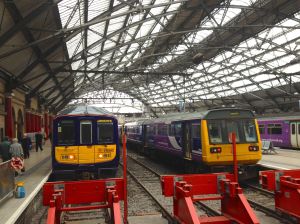Let’s welcome Northern’s newest electric train fleet to service. And welcome its oldest fleet into use.
For they are the same. Northern’s Class 319s entered passenger traffic with that operator on March 5 2015 but they were built in 1990, making them older than the operator’s other electric trains – the ‘321/9s’ of 1991, the ‘323s’ of 1992-96 and the youthful ‘333s’ built over 2001-03.
Perhaps that’s to pick hairs. The ‘319s’ are now working between Liverpool Lime Street and Manchester Airport via the newly electrified Chat Moss route.
Northern 319362 waits in Platform 1 at Liverpool Lime Street on March 5 2015. This was the day ‘319s’ entered service between Liverpool and Manchester Airport. PHILIP HAIGH.
For the time being they are working to timings set for Sprinter diesel trains but that may change in the future. My journey on March 5 suggested the ‘319s’ are quicker off the mark than the diesels but owner Porterbrook lists the acceleration of ‘319s’ as “unknown” making comparisons difficult.
If the ‘319s’ can stretch their legs, their 100mph maximum speed is above the 90mph limit that applies for a good part of the Chat Moss route. By contrast, the ‘150’ and ‘156’ Sprinters are 75mph.
Northern Managing Director Alex Hynes told me that he was not sure whether quicker journeys would follow but said ‘319’ timings would be used when they had more information with which to calculate them.
According to the Northern Electrification Task Force, the new trains provide no increase in capacity when replacing a four-car diesel formation in the peak and add costs to off-peak services that do not need four cars.
The task force adds more generally of prospective northern electric services: “The units so far identified have very poor acceleration and so there will be few benefits from faster journeys due to the frequent stops which characterise the local services in the north and the significant gradients on some routes – these trains have worked predominantly outer suburban routes in flat country.”
Of the ‘319s’ themselves, they still have that deep whine on starting. Their external doors rattle and bang. Internally, their refurbishment looks good with recovered seats and new floor coverings. They’ve kept the 3+2 seating layout. They are a step forward. Let’s hope Northern makes the most of them, not least by transferring redundant diesel units to other routes than need extra capacity.

There’s a lot wrong with the 319s, but nothing that couldn’t be sorted with a proper overhaul. Their most intractable problem is the well-described lack of power. Perhaps I’m being naive, but I can’t see why this couldn’t be improved with new ac motors and (conceivably) the addition of a second powered bogie. This would surely be cheaper than buying new trains.
I’m sure the ‘319s’ would benefit from a new traction package, perhaps AC motors too. It should certainly improve performance and enable notably quicker journey times. Regearing the current trains would also help acceleration although there would be a trade-off in terms of maximum speed. All depends on how much money is available and just what Northern wants from the trains.
I think for now the increase in capacity they provide, by allowing diesel trains to be cascaded elsewhere, is top of the list of the improvements the ‘319s’ bring.
Thank you for taking the time to comment.
Phil